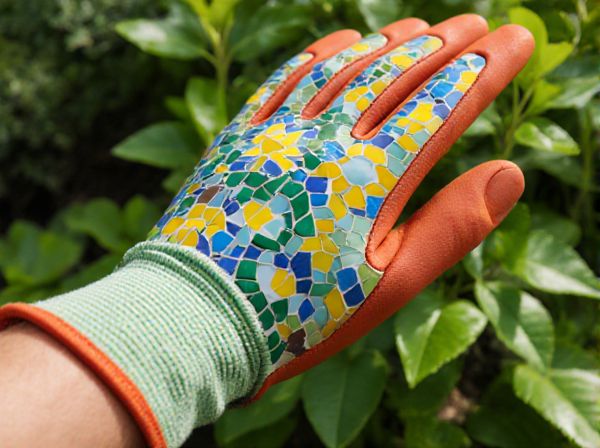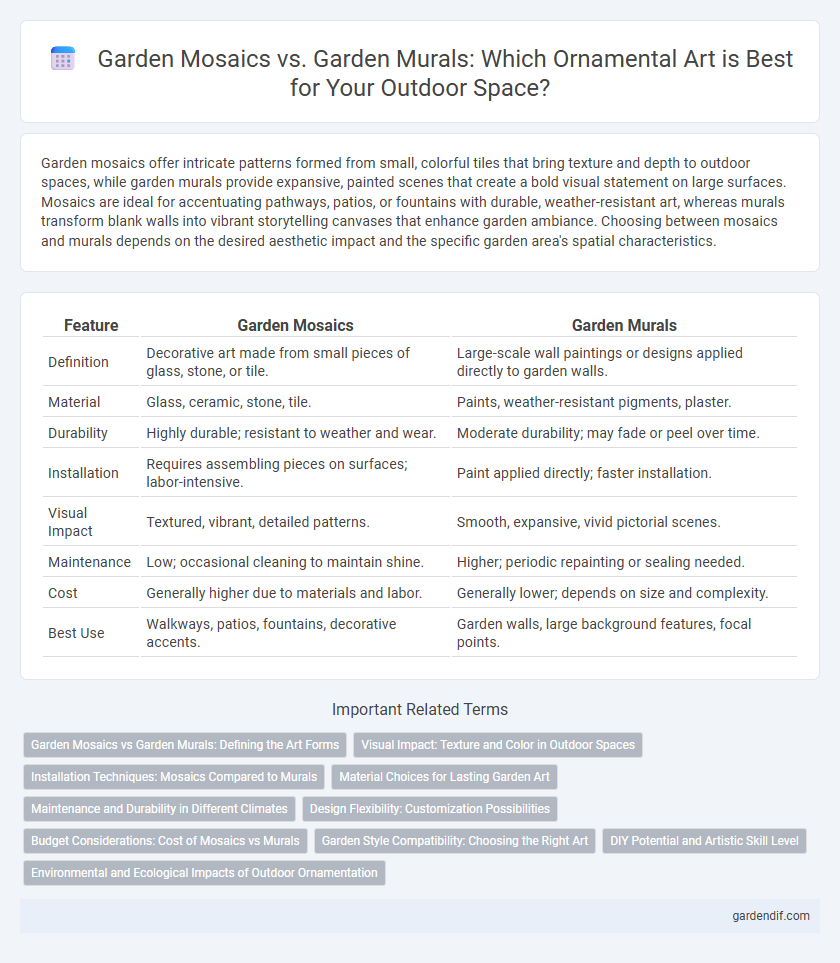
Garden Mosaics vs Garden Murals Illustration
Garden mosaics offer intricate patterns formed from small, colorful tiles that bring texture and depth to outdoor spaces, while garden murals provide expansive, painted scenes that create a bold visual statement on large surfaces. Mosaics are ideal for accentuating pathways, patios, or fountains with durable, weather-resistant art, whereas murals transform blank walls into vibrant storytelling canvases that enhance garden ambiance. Choosing between mosaics and murals depends on the desired aesthetic impact and the specific garden area's spatial characteristics.
Table of Comparison
| Feature | Garden Mosaics | Garden Murals |
|---|---|---|
| Definition | Decorative art made from small pieces of glass, stone, or tile. | Large-scale wall paintings or designs applied directly to garden walls. |
| Material | Glass, ceramic, stone, tile. | Paints, weather-resistant pigments, plaster. |
| Durability | Highly durable; resistant to weather and wear. | Moderate durability; may fade or peel over time. |
| Installation | Requires assembling pieces on surfaces; labor-intensive. | Paint applied directly; faster installation. |
| Visual Impact | Textured, vibrant, detailed patterns. | Smooth, expansive, vivid pictorial scenes. |
| Maintenance | Low; occasional cleaning to maintain shine. | Higher; periodic repainting or sealing needed. |
| Cost | Generally higher due to materials and labor. | Generally lower; depends on size and complexity. |
| Best Use | Walkways, patios, fountains, decorative accents. | Garden walls, large background features, focal points. |
Garden Mosaics vs Garden Murals: Defining the Art Forms
Garden mosaics consist of small, colored pieces of glass, stone, or ceramic meticulously arranged to create intricate patterns or images, offering durability and texture for outdoor decoration. In contrast, garden murals are large-scale paintings applied directly to walls or fences, providing expansive visual stories or themes with bold color and brushwork. Both art forms transform garden spaces, but mosaics emphasize tactile, fragmented design, while murals focus on immersive, continuous imagery.
Visual Impact: Texture and Color in Outdoor Spaces
Garden mosaics create intricate patterns with varied textures and vibrant colors, enhancing outdoor spaces through detailed, tactile surfaces that catch light and create dynamic visual interest. Garden murals offer expansive, colorful scenes that transform walls into large-scale art pieces, providing depth and atmosphere with smooth, continuous textures. Both elevate garden aesthetics, but mosaics emphasize textural richness while murals focus on sweeping color narratives.
Installation Techniques: Mosaics Compared to Murals
Garden mosaics require the precise placement of small, often irregularly shaped tesserae on a prepared surface, typically using mortar or adhesive, demanding meticulous handcrafting skills. In contrast, garden murals are usually painted or printed directly onto large surfaces, allowing for faster installation with tools like brushes or spray equipment. Both techniques benefit from waterproof sealants, but mosaics often demand longer curing times and sturdier substrates to support the added weight of tiles.
Material Choices for Lasting Garden Art
Garden mosaics often use durable materials like ceramic tiles, glass, and stone, which resist weathering and retain vibrant colors over time. Garden murals typically involve painted surfaces on wood, brick, or concrete, requiring protective sealants to prevent fading and damage from moisture. Selecting frost-resistant tiles or UV-resistant paints enhances the longevity of both garden mosaics and murals, ensuring lasting ornamental appeal.
Maintenance and Durability in Different Climates
Garden mosaics constructed from durable materials such as ceramic, glass, and stone exhibit superior resistance to weathering and require minimal maintenance, making them ideal for varying climates including humid, arid, and freeze-thaw environments. In contrast, garden murals, often painted on surfaces like wood or stucco, demand frequent upkeep such as sealing and touch-ups to prevent fading, peeling, and water damage, especially in regions with intense sun exposure or high rainfall. Selecting garden mosaics enhances long-term aesthetic appeal and reduces maintenance efforts, thereby providing a more weather-resilient option for outdoor ornamental design.
Design Flexibility: Customization Possibilities
Garden mosaics offer exceptional design flexibility through intricate patterns made from small, colored tiles that can be precisely arranged to create highly detailed, customized images. In contrast, garden murals allow for larger, more expansive artwork with broader design elements, often painted directly onto surfaces, enabling seamless integration with the surrounding environment. Both styles offer unique customization possibilities, with mosaics excelling in texture and dimensionality, while murals provide extensive visual impact and adaptability to diverse garden themes.
Budget Considerations: Cost of Mosaics vs Murals
Garden mosaics typically involve intricate tile work and labor-intensive installation, often resulting in higher upfront costs compared to garden murals. Murals, painted directly onto surfaces or panels, generally require less expensive materials and can be completed more quickly, making them a more budget-friendly option. However, the long-term durability and maintenance expenses of mosaics may justify the initial investment for projects seeking lasting ornamental impact.
Garden Style Compatibility: Choosing the Right Art
Garden mosaics complement traditional and Mediterranean garden styles with their intricate patterns and textured surfaces, enhancing natural stone pathways and water features. Garden murals suit contemporary and tropical gardens, offering expansive, vibrant scenes that transform walls into artistic focal points. Selecting the right art depends on the garden's architectural elements and plant palette to maintain harmonious visual balance.
DIY Potential and Artistic Skill Level
Garden mosaics offer a flexible DIY potential, allowing beginners to assemble pre-cut tiles or repurpose broken ceramics with basic tools and minimal artistic skill. In contrast, garden murals typically require advanced artistic techniques such as painting or detailed design work, making them better suited for individuals with a higher skill level or professional experience. Both garden mosaics and murals enhance outdoor aesthetics, but mosaics provide a more accessible and customizable option for casual creators.
Environmental and Ecological Impacts of Outdoor Ornamentation
Garden mosaics often utilize recycled glass and ceramic materials, reducing waste and minimizing environmental impact through repurposing. In contrast, garden murals typically involve paint that may release volatile organic compounds (VOCs), potentially harming local air quality and wildlife. Choosing eco-friendly mosaics supports sustainable outdoor ornamentation by promoting resource conservation and reducing chemical exposure in garden environments.
Garden Mosaics vs Garden Murals Infographic

 gardendif.com
gardendif.com